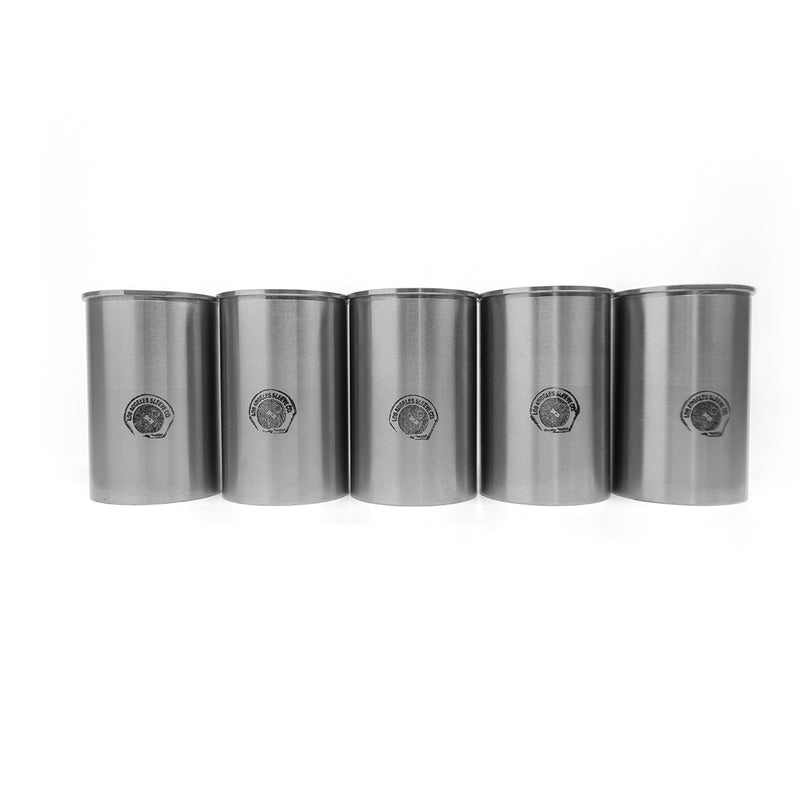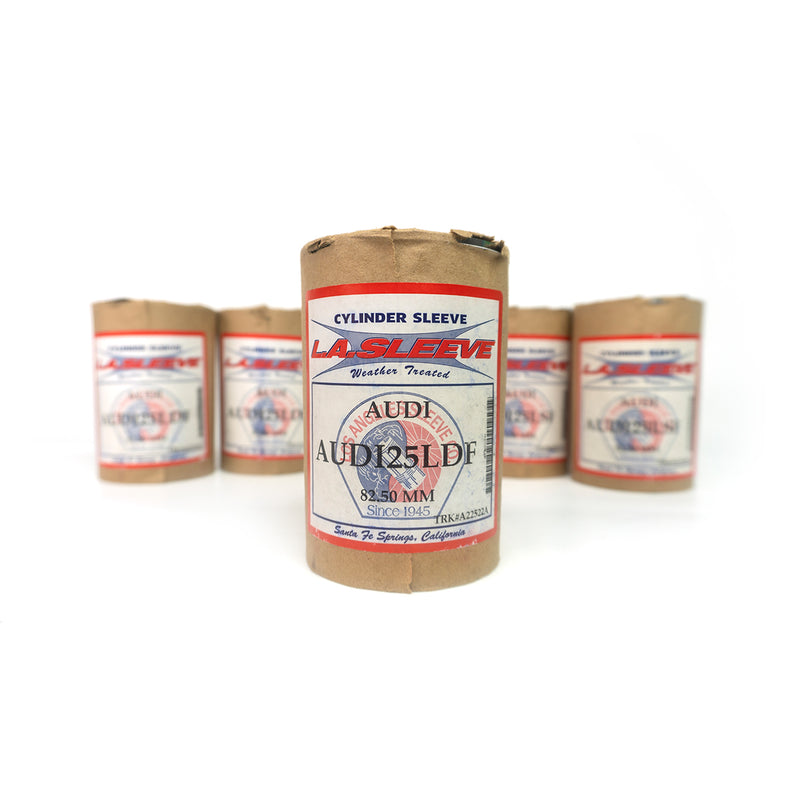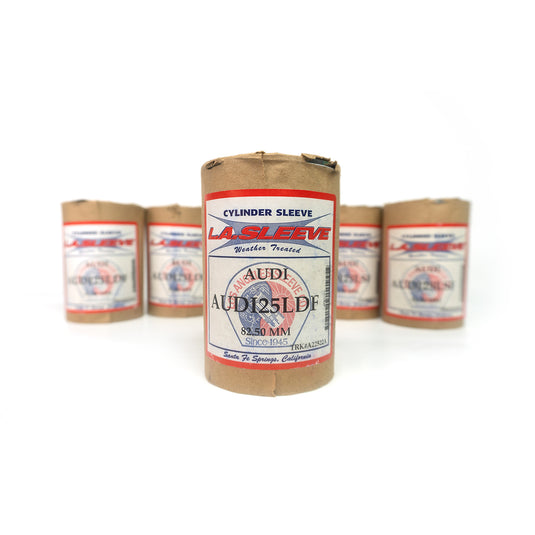


LA Engine Sleeves Audi 2.5L install procedures:
After boring out original aluminum, in preparation for sleeve install, we recommend honing the block’s parent bore aluminum, although not critical. This process ensures better interference pressed fit of the alloy and sleeve surface. Honing the aluminum will effectively plateau, or knock down, the microscopic peaks and valleys caused by the boring cutter tool. This allows a better mating surface, offering more efficient heat transfer from the sleeve to the aluminum. Maybe more importantly, it relieves the pressure of having to get your boring cutter tool perfectly set for the size needed on the interference press fit. No loctite or sleeve sealer needed, if you hone the block’s parent bore aluminum. If you prefer not to hone the aluminum wall surface, Loctite sleeve retainer under the seating area will assist in sealing the fitment.
We recommend an average .0015” pressed fit. Minimum fit is .0005”. Another installation option is a slipped fit for each sleeve (although we don’t recommend this). Some of our installer’s have used this method successfully. The idea is to use .0005” to .001” clearance of sleeve diameter, and block parent bore aluminum. Then, insert sleeves and 618 Loctite. Do not hone the aluminum parent bore, if you choose this option. Again, not recommended but an option if necessary. You will notice the steam passage breaking through the aluminum (see attached photo #6) when you bore the aluminum to size. This is not a problem. The press fit will seal that area. You can use Loctite in that area as well if you desire added protection.
There is no interference pressed fit needed on the outside diameter of the flange against the outer water jacket area. We recommend a slip fit. Or, size on size.
Heat block from 250 to 290 degrees Fahrenheit. Sleeves will fall into place with no resistance. If you choose to heat block, do not freeze the sleeves. Drop those in at room temp only. If you chill or freeze the sleeves, the hypereutectic alloy can crack as the shock of the different temps are no good for that block. You can also freeze the sleeves with liquid nitrogen. If you’re only using liquid nitrogen to freeze sleeves, do not heat the block as noted earlier.
Once all sleeves are installed, we recommend holding the sleeves down under a hydraulic press. Using a steel plate, or torque plate, with approximately a ton a pressure, hold the sleeves down while the block is cooling and crushing the sleeves into place. When completely cold, heat the block up again to approximately 180 degrees, and again rap the sleeves down with the hydraulic press. This is only a precautionary measure, which helps prevent the sleeves from slowly creeping up after installation.
It’s your option whether to deck the top of the sleeves, after installation. It’s not critical, but recommended. Depending on your level of confidence, two options of decking are used. Option #1 is to deck the aluminum prior to sleeve installation. Then, install sleeves allowing from .001” of sleeve protrusion above gasket deck surface. If the sleeve is proud, it will provide a minor pinch for gasket seal. Option #2 is to install the sleeves, and deck both the aluminum and sleeve tops all the way across the deck, with zero sleeve protrusion above the deck surface. Both methods have proved successful. The key to either option is to ensure the sleeves have “bottomed out” on their seating surface.
From that point, simply refer back to your normal boring and honing processes. No need to over think it from there, as it should be elementary machine shop procedures. Let us know if you’ve any other questions.

After boring out original aluminum, in preparation for sleeve install, we recommend honing the block’s parent bore aluminum, although not critical. This process ensures better interference pressed fit of the alloy and sleeve surface. Honing the aluminum will effectively plateau, or knock down, the microscopic peaks and valleys caused by the boring cutter tool. This allows a better mating surface, offering more efficient heat transfer from the sleeve to the aluminum. Maybe more importantly, it relieves the pressure of having to get your boring cutter tool perfectly set for the size needed on the interference press fit. No loctite or sleeve sealer needed, if you hone the block’s parent bore aluminum. If you prefer not to hone the aluminum wall surface, Loctite sleeve retainer under the seating area will assist in sealing the fitment.
We recommend an average .0015” pressed fit. Minimum fit is .0005”. Another installation option is a slipped fit for each sleeve (although we don’t recommend this). Some of our installer’s have used this method successfully. The idea is to use .0005” to .001” clearance of sleeve diameter, and block parent bore aluminum. Then, insert sleeves and 618 Loctite. Do not hone the aluminum parent bore, if you choose this option. Again, not recommended but an option if necessary. You will notice the steam passage breaking through the aluminum (see attached photo #6) when you bore the aluminum to size. This is not a problem. The press fit will seal that area. You can use Loctite in that area as well if you desire added protection.
There is no interference pressed fit needed on the outside diameter of the flange against the outer water jacket area. We recommend a slip fit. Or, size on size.
Heat block from 250 to 290 degrees Fahrenheit. Sleeves will fall into place with no resistance. If you choose to heat block, do not freeze the sleeves. Drop those in at room temp only. If you chill or freeze the sleeves, the hypereutectic alloy can crack as the shock of the different temps are no good for that block. You can also freeze the sleeves with liquid nitrogen. If you’re only using liquid nitrogen to freeze sleeves, do not heat the block as noted earlier.
Once all sleeves are installed, we recommend holding the sleeves down under a hydraulic press. Using a steel plate, or torque plate, with approximately a ton a pressure, hold the sleeves down while the block is cooling and crushing the sleeves into place. When completely cold, heat the block up again to approximately 180 degrees, and again rap the sleeves down with the hydraulic press. This is only a precautionary measure, which helps prevent the sleeves from slowly creeping up after installation.
It’s your option whether to deck the top of the sleeves, after installation. It’s not critical, but recommended. Depending on your level of confidence, two options of decking are used. Option #1 is to deck the aluminum prior to sleeve installation. Then, install sleeves allowing from .001” of sleeve protrusion above gasket deck surface. If the sleeve is proud, it will provide a minor pinch for gasket seal. Option #2 is to install the sleeves, and deck both the aluminum and sleeve tops all the way across the deck, with zero sleeve protrusion above the deck surface. Both methods have proved successful. The key to either option is to ensure the sleeves have “bottomed out” on their seating surface.
From that point, simply refer back to your normal boring and honing processes. No need to over think it from there, as it should be elementary machine shop procedures. Let us know if you’ve any other questions.


Decsription
LA Engine Sleeves Audi 2.5L install procedures:
After boring out original aluminum, in preparation for sleeve install, we recommend honing the block’s parent bore aluminum, although not critical. This process ensures better interference pressed fit of the alloy and sleeve surface. Honing the aluminum will effectively plateau, or knock down, the microscopic peaks and valleys caused by the boring cutter tool. This allows a better mating surface, offering more efficient heat transfer from the sleeve to the aluminum. Maybe more importantly, it relieves the pressure of having to get your boring cutter tool perfectly set for the size needed on the interference press fit. No loctite or sleeve sealer needed, if you hone the block’s parent bore aluminum. If you prefer not to hone the aluminum wall surface, Loctite sleeve retainer under the seating area will assist in sealing the fitment.
We recommend an average .0015” pressed fit. Minimum fit is .0005”. Another installation option is a slipped fit for each sleeve (although we don’t recommend this). Some of our installer’s have used this method successfully. The idea is to use .0005” to .001” clearance of sleeve diameter, and block parent bore aluminum. Then, insert sleeves and 618 Loctite. Do not hone the aluminum parent bore, if you choose this option. Again, not recommended but an option if necessary. You will notice the steam passage breaking through the aluminum (see attached photo #6) when you bore the aluminum to size. This is not a problem. The press fit will seal that area. You can use Loctite in that area as well if you desire added protection.
There is no interference pressed fit needed on the outside diameter of the flange against the outer water jacket area. We recommend a slip fit. Or, size on size.
Heat block from 250 to 290 degrees Fahrenheit. Sleeves will fall into place with no resistance. If you choose to heat block, do not freeze the sleeves. Drop those in at room temp only. If you chill or freeze the sleeves, the hypereutectic alloy can crack as the shock of the different temps are no good for that block. You can also freeze the sleeves with liquid nitrogen. If you’re only using liquid nitrogen to freeze sleeves, do not heat the block as noted earlier.
Once all sleeves are installed, we recommend holding the sleeves down under a hydraulic press. Using a steel plate, or torque plate, with approximately a ton a pressure, hold the sleeves down while the block is cooling and crushing the sleeves into place. When completely cold, heat the block up again to approximately 180 degrees, and again rap the sleeves down with the hydraulic press. This is only a precautionary measure, which helps prevent the sleeves from slowly creeping up after installation.
It’s your option whether to deck the top of the sleeves, after installation. It’s not critical, but recommended. Depending on your level of confidence, two options of decking are used. Option #1 is to deck the aluminum prior to sleeve installation. Then, install sleeves allowing from .001” of sleeve protrusion above gasket deck surface. If the sleeve is proud, it will provide a minor pinch for gasket seal. Option #2 is to install the sleeves, and deck both the aluminum and sleeve tops all the way across the deck, with zero sleeve protrusion above the deck surface. Both methods have proved successful. The key to either option is to ensure the sleeves have “bottomed out” on their seating surface.
From that point, simply refer back to your normal boring and honing processes. No need to over think it from there, as it should be elementary machine shop procedures. Let us know if you’ve any other questions.

After boring out original aluminum, in preparation for sleeve install, we recommend honing the block’s parent bore aluminum, although not critical. This process ensures better interference pressed fit of the alloy and sleeve surface. Honing the aluminum will effectively plateau, or knock down, the microscopic peaks and valleys caused by the boring cutter tool. This allows a better mating surface, offering more efficient heat transfer from the sleeve to the aluminum. Maybe more importantly, it relieves the pressure of having to get your boring cutter tool perfectly set for the size needed on the interference press fit. No loctite or sleeve sealer needed, if you hone the block’s parent bore aluminum. If you prefer not to hone the aluminum wall surface, Loctite sleeve retainer under the seating area will assist in sealing the fitment.
We recommend an average .0015” pressed fit. Minimum fit is .0005”. Another installation option is a slipped fit for each sleeve (although we don’t recommend this). Some of our installer’s have used this method successfully. The idea is to use .0005” to .001” clearance of sleeve diameter, and block parent bore aluminum. Then, insert sleeves and 618 Loctite. Do not hone the aluminum parent bore, if you choose this option. Again, not recommended but an option if necessary. You will notice the steam passage breaking through the aluminum (see attached photo #6) when you bore the aluminum to size. This is not a problem. The press fit will seal that area. You can use Loctite in that area as well if you desire added protection.
There is no interference pressed fit needed on the outside diameter of the flange against the outer water jacket area. We recommend a slip fit. Or, size on size.
Heat block from 250 to 290 degrees Fahrenheit. Sleeves will fall into place with no resistance. If you choose to heat block, do not freeze the sleeves. Drop those in at room temp only. If you chill or freeze the sleeves, the hypereutectic alloy can crack as the shock of the different temps are no good for that block. You can also freeze the sleeves with liquid nitrogen. If you’re only using liquid nitrogen to freeze sleeves, do not heat the block as noted earlier.
Once all sleeves are installed, we recommend holding the sleeves down under a hydraulic press. Using a steel plate, or torque plate, with approximately a ton a pressure, hold the sleeves down while the block is cooling and crushing the sleeves into place. When completely cold, heat the block up again to approximately 180 degrees, and again rap the sleeves down with the hydraulic press. This is only a precautionary measure, which helps prevent the sleeves from slowly creeping up after installation.
It’s your option whether to deck the top of the sleeves, after installation. It’s not critical, but recommended. Depending on your level of confidence, two options of decking are used. Option #1 is to deck the aluminum prior to sleeve installation. Then, install sleeves allowing from .001” of sleeve protrusion above gasket deck surface. If the sleeve is proud, it will provide a minor pinch for gasket seal. Option #2 is to install the sleeves, and deck both the aluminum and sleeve tops all the way across the deck, with zero sleeve protrusion above the deck surface. Both methods have proved successful. The key to either option is to ensure the sleeves have “bottomed out” on their seating surface.
From that point, simply refer back to your normal boring and honing processes. No need to over think it from there, as it should be elementary machine shop procedures. Let us know if you’ve any other questions.







